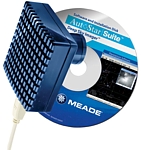![]() Cameras most widely used for astronomy: CCDs.
Cameras most widely used for astronomy: CCDs.
CCD cameras are very sensitive electronic devices that capture light and form an image from it, but at the same time they are very fragile, especially if they must operate in the hostile environment of space. CCD means "Load Coupled Device"a type of photosensitive chip similar to those used in home video cameras.
Instead of moving images, CCD cameras record long exposures, where light falls on a series of pixels arranged in a grid on the chip. At the end of the exposure, each pixel reads the voltage associated with the amount of light it has received. These figures are digitized (i.e. converted into binary numbers: zeros and ones) and sent to the computer, which displays the image on the screen.
Characteristics of CCDs
Most CCD cameras are monochrome, accompanied by filters (comparatively better system than a color CCD). To create a color image 3 exposures must be taken, one in red filter, another in green and another in blue, which are then merged on a PC using an image processor. Modern observatories use extremely sensitive CCD systems (which are also often cooled with liquid nitrogen to prevent noise and artifacts from appearing in the final image). They consist of a photosensitive electronic semiconductor plate, with hundreds of filaments arranged in a mesh, creating hundreds of tiny photodiodes sensitive to the light collected by the telescope and defining the basic element of the image: the pixel, which when stimulated by light energy, release electrons and produce the image.
 CCD cameras are excellent tools that allow not only astrophotography, but also more specific and technical tasks (e.g. variable star photometry) and is widely used by advanced amateurs. Its main advantage lies in its high sensitivity and obtaining a digital image possible to process and manipulate in many ways, greatly improving if our goals include obtaining more "artistic" and attractive images. Of course, apart from the fact that CCDs are usually an expensive accessory (~200 USD), they need to be attached to a telescope and ideally to a laptop to get the most out of them.
CCD cameras are excellent tools that allow not only astrophotography, but also more specific and technical tasks (e.g. variable star photometry) and is widely used by advanced amateurs. Its main advantage lies in its high sensitivity and obtaining a digital image possible to process and manipulate in many ways, greatly improving if our goals include obtaining more "artistic" and attractive images. Of course, apart from the fact that CCDs are usually an expensive accessory (~200 USD), they need to be attached to a telescope and ideally to a laptop to get the most out of them.


